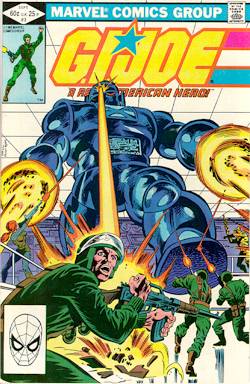
Walls of Death!
Credits: Larry Hama (writer), Herb Trimpe (co-writer/artist), Chic Stone (inker), Jim Novak (letterer), Christie Scheele (colorist), Denny O’Neil (editor)
Feature Characters: Breaker, Clutch, Flash, Hawk, Scarlett, Stalker, Steeler
Supporting Characters: None
Guest Appearances: Colonel Brekhov, Daina, Horrorshow, Schrage, Stormavik (all appear next in G.I. Joe Yearbook #2)
Villains: Cobra Commander, Cobra commandos (Copperhead and Rattler named, both die in this story; Copperhead not to be confused with the character introduced in G.I. Joe Yearbook #1), Cobra troops (one impersonates Cobra Commander)
Story: The G.I. Joe team joins forces with the October Guard to retrieve the top-secret aircraft stolen by Cobra. Though victorious, Hawk reveals to the team they were merely a decoy to distract Cobra from the actual retrieval mission.
Reagan-era Goodness: Aside from the obvious US-USSR stuff, Breaker jokes about giving the Shah back upon encountering an Iranian border patrol. The Shah, of course, was overthrown in 1980 and fled to the US in exile.
Review: This story immediately follows issue #6 and is a reasonably strong follow-up. G.I. Joe and the October Guard team up only out of convenience, not because they’re willing to throw out their Cold War-honed ideologies. While everyone else recognizes the alliance for the uneasy matter that it is, Scarlett loudly bristles at the idea of working with “these lousy Reds.” And of course, once it’s clear they have the upper hand, the October Guard turns on the G.I. Joe team.
Cobra bases themselves in Iran, which was already considered a hotbed of terrorist activity at the time with the rise of the Ayatollah Khomeini and the hostage crisis of 1980. However, their bunker is rife with ridiculous booby traps like giant falling walls of stone, flooding tunnels, and a pit of King Cobras, better found in Raiders of the Lost Ark (someone even mentions Steven Spielberg when they encounter the snakes). This is easily the weakest part of the story but it’s brief, thankfully.
The story ends with Hawk revealing the team's true purpose as a decoy. It's quite clear that he's just as pissed off as the Joes. He doesn't want to be the bad guy but orders are orders. This is the first time we see Hawk in a position like this, unfortunately it won't be the last.





